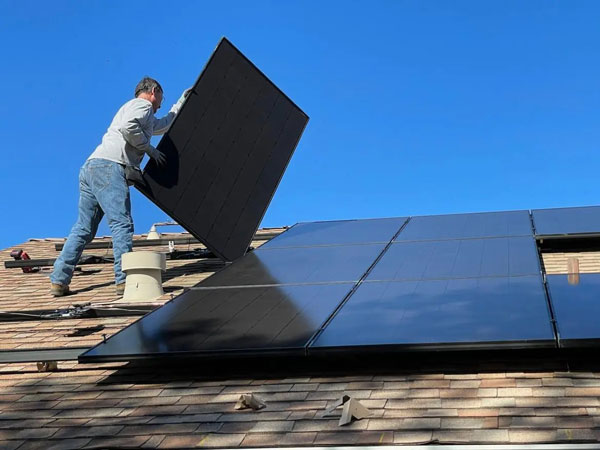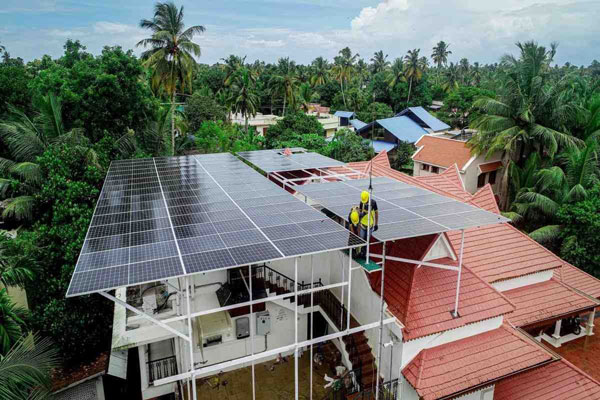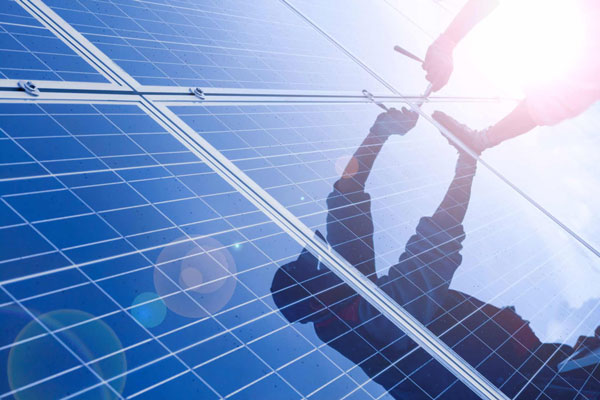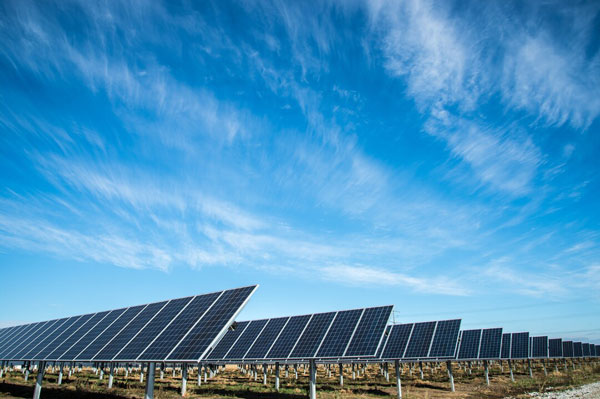Type of Solar Panels
Solar panel technology is different and it affects the efficiency and cost of installation. Three types of solar panels, monocrystalline, polycrystalline, and thin-film, each have their own advantages and cost implications.
Monocrystalline panels have higher efficiency and a 15-20% efficiency rate. It looks more traditionally, from a single, continuous crystal structure. Such a panel in the real world will be a 300-watt panel and will take up about 18 square feet. Monocrystalline-type panels are more expensive, but efficiency and longevity sometimes justify their high cost. In a real-world example, a residential solar power system in California with monocrystalline panels would be about $15,000 after incentives. Savings on electricity bills would pay for the investment in about 8 years.
Polycrystalline technology results in panels of a blue hue and less uniform appearance. They use multiple silicon crystals and as a result are a little less efficient, 13-16%. Standard installation is a 250-watt panel – less efficient, but cheaper than monocrystalline, at a cost of 10-20% lower. Thus, polycrystalline solar panels provide greater opportunities for savings. They are likely to be in demand for larger installations, in casus when space is not a problem, and in an example – in a warehouse in Arizona, a 50,000 square feet installation with polycrystalline solar panels. This solution will also allow investment in a shorter payback period due to lower initial costs. This payback period is the time it takes for savings on electricity bills to cover the full amount spent on the system. On a large warehouse purchasing polycrystalline panels, the payback period will be significantly reduced.
Thin-film technology is the most flexible of the three and may not need additional support. Being perfectly clean and lightweight, the panel will achieve the lowest efficiency, 10-13%. A usage case for such installation is when electricity is needed in a place where it is unavailable. A venue for a one-time concert in Nevada will purchase thin-film solar panels to power the stage’s lighting and sound. It’s too expensive to buy such a system for an average American who has electricity at home. They are the cheapest, the most affordable in general.

Scale of Installation
The first and most important factor that will determine the total price and cost-efficiency of getting a solar installation is its scale. An average residential installation ranges from 5 kW to 20 kW. A standard average of cost per watt is from $2.50 to $3.50, as influenced by the type of panels and complexity of installation. Thus, an average 10 kW system for a house might cost from $25,000 to $35,000 before incentives. Many homeowners might try to install a smaller unit when they do not have enough money or enough room on their roof for a larger one. In this case, the financial effect and the output of energy from such a system will also be smaller. For instance, a 7 kW installation in Texas might save up to 75% on monthly electricity bills, paying itself off in about 10 years.
In commercial projects, the size of the structure with the installation also influences wastes and expenses. Regular projects might start at 50 kW and go to several megawatts. Typically, the price goes down due to the economy of scale, down to $1.00 and $2.00 per watt and thus making a 500 kW structure might cost from $500,000 to $1,000,000 for the company. It should be noted that many businesses that use such a size of installations have an extensive physical footprint, such as manufacturing plants or distribution centers. An average distribution center in the US has a 500 kW system set up, which covers a lot of the power needed for its operations. An average payback time for such an installation is from 5 to 7 years.
The array of solar panels that goes to the development of a solar farm is involved with the price of developing the land. The lowest per kilowatt price is typical for solar farms that produce one megawatt of energy or more. In this case, the cost of such installations might go down below $1.00 due to the purchase of materials and smaller scale. A 100 MW solar farm might also occupy a vast amount of land – around 200 acres – and cost about $100 million to develop. The benefits of building such a farm are the fact that it will be sending all this power into the grid, which in turn will feed tens of thousands of homes. For instance, a typical farm in Nevada produces over 300 GWh per year, which is enough to feed around 30,000 houses.
Labor and Installation Costs
Cost of labor and the process of installing solar panels are major factors that determine the overall expenses of solar power systems. The expenses depend on the complexity of the installed solar system, local cost of labor, and interdependence between the number of solar panels and overall complexity of the installed systems.
Residential installation labor costs
Labor costs can be between 10 percent to 25 percent of overall expense. Both labor costs and additional costs, such as, permits, are less for smaller systems. For a 6-kW system situated in Florida with a simple single-story house roof, it could be less than $2,000. An average labor cost of a similarly sized residential project is between $1,000 to $5000. Installation expenses for the roof outside Florida, and especially those with a second story increase when complexities are present in the structure. Labor costs can be 10 times higher if there is a complicated roofing structure and additional electrical costs.
Commercial Installation Labor Costs
Commercial solar installations require more labor due to the size and complexity of solar set-ups. Labor is cheaper per watt than residence’s solar because of economies of scale but final costs depend on the size of installed solar system. For a 100kW set up, the cost may range between $7,000 to $20,000. Labor costs for a commercial roof top installation in New York can be costly. Installation of a large roof top commercial set up requires scaffolding, safety measures and additional costs for electrical upgrades to cater for the large system.
Specialized Labor and Equipment Costs
Costs are higher due to complexities of these installations and include ones in uneven terrains or difficult ground not good for regular installations. There is need for specialized mounting equipment and more people to help in lifting of the solar equipment. An additional 15 percent to 30 percent is charged in these types of installations. Another concept is the installation of advanced commercial equipment needing experienced electricians and specialist solar technicians.
Site Accessibility
Since the overall cost of a solar system is, to a great extent, defined by the site at which it is to be installed, site access is key as well. Specifically, areas that lack or have limited access can be far more expensive to install a solar system in than those that do not. For instance, a rooftop in the denser part of the city might require a crane, special machinery, or a lot of work by hand to be able to accommodate and install a solar system. Similarly, a site on a hill or near the river can be far more efficient to install when water or electricity to transport heavier solutions to the working site are taken into account. In this scenario, the final cost will also be reflected in the cost to dimensionally transport. Fujita and Fujii provide that the cost of syntax is typically about 0.25 MLJ or milliards of local currency, or roughly equivalent to 25% of the initial project cost in a given location. Arguably, the cost of labor of auto mechanics or other laborers will also be nearly trebled in remote locations, raising the initial cost even further.
Actual Application Scenario
In a scenario in which a solar power system is installed to provide the electricity in a mountainous region, the cost of laying to provide the panels with a stable foundation will create a wedge for at least 15% to 20% greater installation cost than on flat ground. There should also be a series of steps followed, from the analysis of the area to determine scope and need to the steps of applying the panels, mounting them and hollow blocks in the associated hole.

Permits and Regulations
One of the critical elements of the process of solar installation, which also directly affects its costs, entails the necessity of navigating the maze of permits and regulations. The need to comply with local, state, and federal regulations affects the duration and cost of acquiring necessary approvals, which may range dramatically.
Permitting Process
The permitting process consists of several stages, including initial application, inspection and review, and modification and final approval. In California, the solar installers must adhere to the California Solar Permitting Guidebook’s requirements, including requirements for site-specific engineering assessments. In other cases, the opportunity cost of delayed approvals and potential fines may qualify as different components of the total cost.
Quantitative Impact on Costs
Permitting accounted for up to 5% of total installation costs in the study performed by the National Renewable Energy Laboratory for jurisdictions with more restrictive regulations. Moreover, time delays are often much longer than fees, as obtaining permission to build usually ranges from several weeks to even several months. As a result, these indirect costs include the need to prolong labor contract with the use of equipment on behalf of hire.
Real-World Compliance Example
Consider that solar panels are to be installed in a historic district, where the aesthetic and heritage preservation laws are stringent. The need to comply with these laws provides for the necessity to apply for special permissions, which are almost always more expensive and require the conduct of detailed architectural reviews. Thus, permitting may potentially increase the total cost by 5-10%, representing an opportunity cost. To sum up, planning a solar project, developers must recognize compliance costs as contingent on the location.choices.
Financing Options
Solar installations’ available financing options and the extent to which they can be chosen greatly influence the expense and feasibility of the renewable energy source for regular and commercial customers. Different financing options have an effect on how much a solar system would wrack up in costs, as well as final saving numbers and return on investment total. The financing choices usually include solar leases, power purchase agreements, solar loans, and directly purchased panels.
Example of Solar Loans
An instance of a solar option is a lease — similar to a car lease, the homeowner pays a fixed monthly fee for the panels, which generally comes up as less than their regular electricity bill. The upfront cost hovers extremely close to zero, although long-range savings might not be as rewarding as simply making the purchase. Alternatively, solar loans are a differential kind of wealth — in most cases, they offer homeowners the possibility of installing solar panels on their rooftops for no upfront cost. Because these homeowners are considered the owners, they also benefit from federal tax credits and an appreciating home curb appeal. IRT calculations show that the ENERGY STAR PV Calculator offers data that shows that with local electricity as well as solar credits, a solar loan capitalization managed to bring the return on investment of a solar installation to under 8 years. Simulation apps were also applied in order to determine that the payback times tended to drop significantly with loan repayment financing.
A Real-Life Application of Financing
As an example of a real scenario of taking out a PPA for solar installations, imagine a business with average energy demand sights op for a PPA with a solar company. The business has average energy use and is in a region wherein the price of electricity is rather high. The PPA’s terms and agreement stipulated that the company would pay for power derived from solar installations and produced by the sun’s light for less than what a local utility company would charge for their energy. Meanwhile, the business is not required to put any sort of money investment into buying the selling equipment. With such a plan, the company would effectively save around 30% on their energy bills for the next 20 years.
Incentives and Subsidies
Government incentives and subsidies are aimed at reducing the financial barriers before solar adoption. Therefore, solar energy becomes more affordable, and the amount of investment funds to be provided is minimized. The overall economic feasibility of projects improves, which permits reducing the payback period of implemented solutions.
Incentives and their Description
In the USA, the federal government makes an effort to encourage the adoption of solar energy, introducing the Solar Investment Tax Credit (ITC). Thus, house owners and businesses may deduct a particular percentage of the solar installations from their federal taxes. The deduction allowed in 2021 is 26% of the total system cost. In addition to the federal ITC, various states propose their specific local incentives and rebates. For instance, in California, the combination of the federal ITC and the additional local rebate allows reducing the payback period by even 50%. If to consider a higher reduction of 40%, it is also clear from Formula 1 and Table 1. Therefore, the payback period will amount to 10 years.
The Example of Incentives Description
A residential solar project is designed, and the house owner will be eligible for federal ITC of 26% and the local utility rebate of $2000. The total price of the installation amounts to $20,000, and ITC results in its reduction in price by $5200. Therefore, the efficiency of the house owner will be provided with a certain amount of money, reducing the total installation cost to $12,800. It will be possible to achieve that result with the combination of ITC and the local rebate, presenting the bonuses as an additional bonus to the general payback period. Thus, the use of incentives may become a crucial factor for improving the overall financial effectiveness of the projects.



